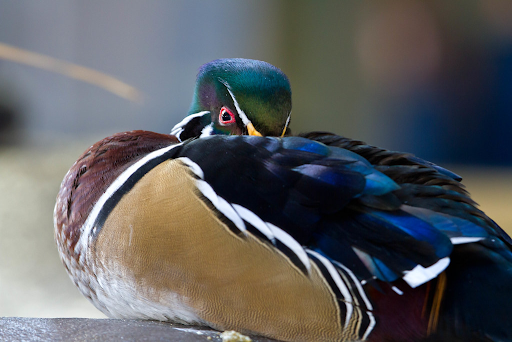Not Your Ordinary Dozing Ducks
You may have seen a flock of ducks at your local park resting from a long day of swimming and hunting for bread. If you watch them closely, you will see that some of them are sleeping with one eye open, watching your movements and assessing your threat potential. This is not unusual. In fact, this behavior, called unihemispheric sleep, occurs in some aquatic mammals and birds.1
Unihemispheric sleep is a unique behavior in which half of an animal’s brain is awake while the other half is asleep, frequently characterized by specific body postures and asymmetric eye closure (one eye remains open while the other is closed).4 In birds, unihemispheric sleep is specifically named unihemispheric-monocular sleep (Un-Mo sleep). On the other hand, in aquatic mammals like cetaceans (whales, dolphins and porpoises) and pinnipeds (seals), unihemispheric sleep is named unihemispheric slow-wave sleep (USWS). For aquatic mammals, unihemispheric sleep serves as a tactic to prevent drowning, allowing them to surface so they can breathe while underwater. For birds, it serves as a way for flocks to watch for predators while resting briefly during long migration journeys.3
With maintaining wakefulness in one half of the brain, these animals exhibit an interesting partial state of consciousness, exemplifying the true fluidity of brain states across the animal kingdom. This also brings to question the boundaries or lack thereof of consciousness in humans, and if there is some relationship between the sleep habits of unihemispheric sleeping animals and our own sleep states.
Techniques for Measuring Sleep
To study sleep patterns and brain activity during unihemispheric sleep, scientists use electroencephalography (EEG) which records brain activity, and magnetoencephalography (EMG) which records muscle response. During sleep, muscle atonia (loss of muscle movement) caused by the brain signaling to the body’s muscles is a primary characteristic of sleep, making EMGs an appropriate indicator for sleep in animals. These technologies, placed on the scalp of animals, measure the magnetic fields generated by neuronal activity in the brain. These magnetic field patterns have unique shapes during different stages of arousal, allowing scientists to compare, analyze, and characterize an animal’s brain state.
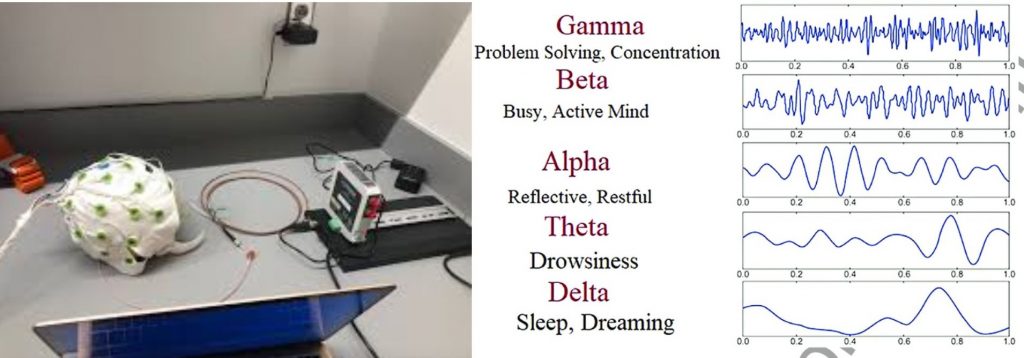
More specifically, EEG activity during bihemispheric sleep is characterized by slow waves and high amplitudes (peaks), while EEG activity when an animal is awake is characterized by fast waves and low amplitudes. EMG activity is typically high amplitude during the wake state, while minimal activity is seen in the sleep state. Understanding the distinctive signatures of the EEG and EMG brain activity when an animal is asleep or awake is critical to dissecting the inner workings of unihemispheric sleep, especially since animals like birds exhibit short, intermingled episodes of varying sleep states.
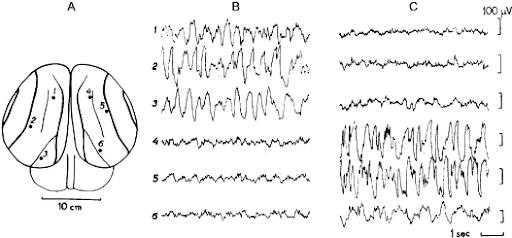
Unihemispheric Sleep in Birds
A prime animal model researchers have used to study unihemispheric sleep in birds is Gallus gallus, the domestic chick. In chicks, EEG recordings of Un-Mo sleep are characterized by activity with high amplitude and slow waves in one hemisphere with the contralateral, or opposite, eye shut. In the other hemisphere, the EEG activity showed fast waves with low amplitudes, again with the contralateral eye open. This behavior is in part due to the physiological feature that neurons from the brain in charge of movement and senses (sensory and motor fibers) cross the body’s midline to control the opposite side of the body. EMG recordings of birds have shown activity in the brain hemisphere associated with the open eye and reduced activity in the brain hemisphere associated with the closed eye.
Un-Mo sleep only makes up around one and a half to two percent of the chick’s total activity, with Un-Mo sleep events intermingled with bihemispheric slow wave sleep (BSWS). Interestingly, the Un-Mo sleep pattern is correlated with the development of the brain in young chicks. From birth to day eight, the chick’s sleep behavior is dominated by the left hemisphere followed by the right from day eight to 15. As such, the chick would more likely exhibit left hemisphere Un-Mo sleep with right eye closure during the first seven days post birth followed by right hemisphere Un-Mo sleep with left eye closure the week after. Even the amount of light exposure the chick’s egg receives influences the dominance of left or right hemisphere sleep.4
Interestingly, in inflight migratory birds, there is still EMG activity associated with the sleeping brain hemisphere, but the level of activity is reduced. To investigate this phenomenon, research teams from Germany, Switzerland, and Ecuador collaboratively developed and attached small flight data recorders to the heads of frigate birds, which nest on the Galapagos islands and can have nonstop flights for up to 10 days. The birds were found to sleep for up to a few minutes while soaring, primarily with one hemisphere awake at a time. Additionally, researchers found that the hemisphere that was awake as the birds circled rising air currents was the side with the open eye facing the turn, suggesting that these birds were intentionally keeping an eye on the surrounding area for other birds to avoid collisions.11
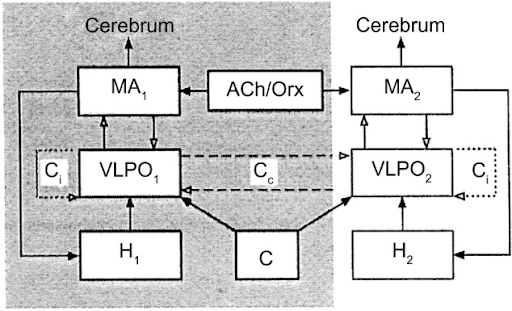
This sleep pattern is hypothesized to be caused by asymmetrical sleep-wake cycles within brains of birds and marine mammals. The facilitation of the isolation of slow wave sleep to one hemisphere is believed to be regulated by the corpus callosum, a bundle of nerve fibers that connect the right and left brain hemispheres. While the neural mechanisms are not fully understood, unihemispheric sleep is closely tied to the development, survival, and health of these animals.4
Simulating Unihemispheric Sleep in Humans
Studies in cats and humans with severed corpus callosum exhibited invariable bihemispheric sleep, suggesting more complex mechanisms for unihemispheric sleep circuits. However, there have even been rare simulations of unihemispheric sleep in humans under conditions of potential threat or novel environments. Scientists like Masako Tamaki recorded hemispheric asymmetry in brain activity during slow wave sleep during the first night patients in her study slept at the sleep laboratory. This shallower and differential hemispheric sleep during the patient’s first night in the new environment was dubbed the “first night effect” and closely resembles the unihemispheric sleep exhibited by birds and cetaceans (aquatic mammals).3
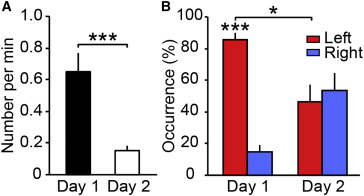
In addition to this imbalance in brain activity in novel environments, humans also are capable of lucid dreaming, a phenomenon where an individual achieves conscious awareness that they are dreaming while asleep. In one study, undergraduate students at Bonn University were trained to lucid dream and signal lucidity while sleeping through a sequence of eye movements (look left-right-left pause left-right-left). EEG recordings were found to be higher in activity and power compared to regular REM sleep EEG recordings, suggesting a form of hybrid sleep state.9 This study suggest that lucid dreaming is a state consisting of both REM and wake state features, refuting previous conceptions that lucid dreaming is a REM sleep phenomenon. On the other hand, sleepwalking is the opposite phenomenon where the brain exhibits NREM sleep while muscle movement is uninhibited.2
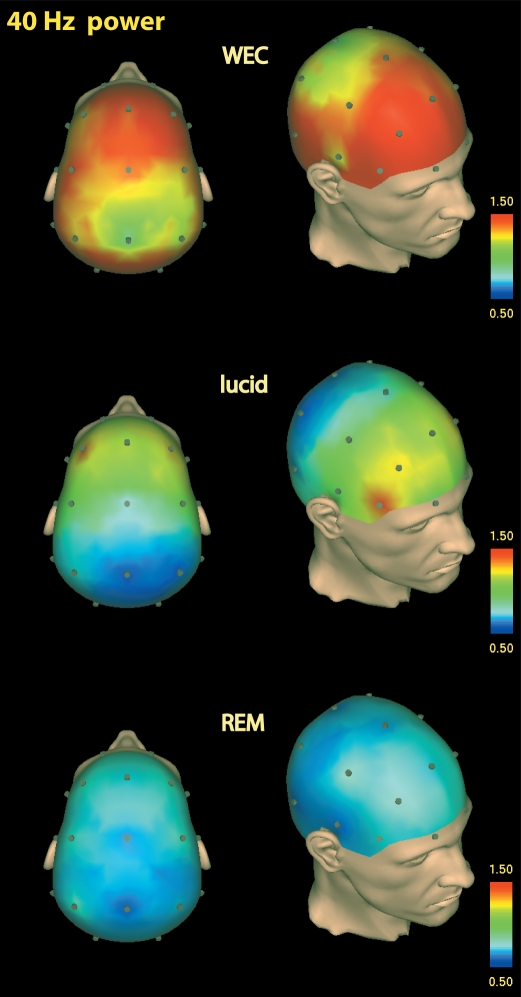
While humans cannot precisely experience unihemispheric sleep, phenomena like the “first night effect,” sleep walking, and lucid dreaming suggest that the relationship between consciousness and sleep is far more complex than previously understood, and that regions of the brain can be awake while others are asleep.
However, despite this, it appears that unihemispheric sleep is solely observed in aquatic mammals and birds. These animals evolutionarily benefit from such sleep, as it is critically tied to their survival, whether it facilitates proper development or sustains long travels in the skies and sea. Humans, on the other hand, have no such need for this form of sleep. So, the next time you see a bird napping by the pond, remember that its one open eye might just be a clever strategy, honed by evolution to navigate a world where staying half-awake is key to survival.
Acknowledgements
I would like to thank Professor Jerry Siegel for reviewing my article for accuracy. I would also like to thank the BSJ editorial staff for peer reviewing my article.
References
- Konadhode, R. R., Pelluru, D., & Shiromani, P. J. (2016). Unihemispheric Sleep: An Enigma for Current Models of Sleep-Wake Regulation. Sleep, 39(3), 491–494. https://doi.org/10.5665/sleep.5508
- Magazine, S., & Stromberg, J. (n.d.). The Science of Sleepwalking. Smithsonian Magazine. Retrieved October 6, 2024, from https://www.smithsonianmag.com/science-nature/the-science-of-sleepwalking-97626685/
- Manoach, D. S., & Stickgold, R. (2016). Sleep: Keeping One Eye Open. Current Biology, 26(9), R360–R361. https://doi.org/10.1016/j.cub.2016.03.041
- Mascetti, G. G. (2016). Unihemispheric sleep and asymmetrical sleep: Behavioral, neurophysiological, and functional perspectives. Nature and Science of Sleep, 8, 221–238. https://doi.org/10.2147/NSS.S71970
- Mascetti, G. G. (2021). Adaptation and survival: Hypotheses about the neural mechanisms of unihemispheric sleep. Laterality, 26(1–2), 71–93. https://doi.org/10.1080/1357650X.2020.1828446
- Mascetti, G. G., & Vallortigara, G. (2001). Why do birds sleep with one eye open? Light exposure of the chick embryo as a determinant of monocular sleep. Current Biology, 11(12), 971–974. https://doi.org/10.1016/S0960-9822(01)00265-2
- Rattenborg, N. C., Amlaner, C. J., & Lima, S. L. (2000). Behavioral, neurophysiological and evolutionary perspectives on unihemispheric sleep. Neuroscience & Biobehavioral Reviews, 24(8), 817–842. https://doi.org/10.1016/S0149-7634(00)00039-7
- Tamaki, M., Bang, J. W., Watanabe, T., & Sasaki, Y. (2016). Night Watch in One Brain Hemisphere during Sleep Associated with the First-Night Effect in Humans. Current Biology, 26(9), 1190–1194. https://doi.org/10.1016/j.cub.2016.02.063
- Voss, U., Holzmann, R., Tuin, I., & Hobson, J. A. (2009). Lucid Dreaming: A State of Consciousness with Features of Both Waking and Non-Lucid Dreaming. Sleep, 32(9), 1191–1200.
- Zyga, L. & Phys.org. (n.d.). Researchers model unihemispheric sleep in humans. Retrieved September 23, 2024, from https://phys.org/news/2019-07-unihemispheric-humans.html
- First evidence of sleep in flight. (n.d.). Retrieved October 21, 2024, from https://www.mpg.de/10673637/frigatebirds-sleep
Images Cited
- Mrachina, J. (2012). I Always Feel Like (Somebody’s Watching Me)—[Explored Feb 2, 2012] [Photo]. https://www.flickr.com/photos/w4nd3rl0st/6805179689
- Sdwilli. (2019). English: Eeg cap [Graphic]. Own work. https://commons.wikimedia.org/wiki/File:EEG_Cap_on_melon.jpg
- Singh, Samantaray, S., Jena, S., Mantri, J., Misra, C., & Patra, S. (2021). Automatic Sleep EEG Classification with Ensemble Learning Using Graph Modularity (pp. 1–24). https://doi.org/10.1201/9781003147817-1
- Mukhametov, L. M., Supin, A. Y., & Polyakova, I. G. (1977). Interhemispheric asymmetry of the electroencephalographic sleep patterns in dolphins. Brain Research, 134(3), 581–584. https://doi.org/10.1016/0006-8993(77)90835-6
- Mascetti, G. G. (2016). Unihemispheric sleep and asymmetrical sleep: Behavioral, neurophysiological, and functional perspectives. Nature and Science of Sleep, 8, 221–238. https://doi.org/10.2147/NSS.S71970
- Tamaki, M., Bang, J. W., Watanabe, T., & Sasaki, Y. (2016). Night Watch in One Brain Hemisphere during Sleep Associated with the First-Night Effect in Humans. Current Biology, 26(9), 1190–1194. https://doi.org/10.1016/j.cub.2016.02.063
- Voss, U., Holzmann, R., Tuin, I., & Hobson, J. A. (2009). Lucid Dreaming: A State of Consciousness with Features of Both Waking and Non-Lucid Dreaming. Sleep, 32(9), 1191–1200.
